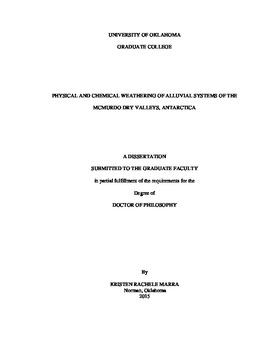| dc.description.abstract | Chemical weathering of sediments derived from wet-based glaciation is typically correlated to water discharge rates, wherein glacially produced fines are susceptible to chemical alteration due to abraded mineral textures and high reactive surface area. Chemical weathering processes affecting sediments in cold-based glacial systems are less well constrained due to a presumed lack of sediment production via glacial grinding. This dissertation investigates chemical weathering trends within the fine-grained (<63 µm; silt and clay) fraction of sediments collected from meltwater streams emanating from cold-based glaciers in the McMurdo Dry Valleys (MDV; Wright and Taylor Valleys) by integrating grain size, BET surface area, and whole-rock geochemistry. In Wright Valley (Clark Glacier stream), the silt and clay (mud) fraction is typically coarser grained (higher silt content) and consists primarily of pyroxenes, quartz, and feldspars, with the percentages of pyroxenes and quartz systematically increasing downstream. The percentage of phyllosilicates is relatively low (4-18%) and decreases with downstream distance. In contrast, fine-grained Taylor Valley sediments (Delta Stream) exhibit lower percentages of both pyroxene and quartz and a higher percentage of phyllosilicates (30-43%), and concentrations of both primary minerals and phyllosilicates remain consistent in abundance down the stream transect. BET surface areas in Clark Glacier stream range from 2.0-29.0 m2/g and from 19.9-70.6 m2/g in Delta Stream. Standard chemical weathering indices, such as the Chemical Index of Alteration (CIA), indicate that chemical weathering is occurring within the silt and clay fractions of Antarctic stream sediments and is particularly pronounced in Delta Stream where surface area is > 40 m2/g. Utilization of MFW and A-CN-K plots, however, are more effective in discerning the extent and nature of chemical weathering in these stream systems. At the highest measured surface areas in Delta Stream, loss of Ca and Na is evident in the fine-grained sediments, suggesting pitting and/or incongruent dissolution of pyroxenes and feldspars as well as development of amorphous mineral phases via the initiation of chemical weathering, resulting in higher measured BET surface areas. Clark Glacier stream sediments do not exhibit comparable leaching trends in the fine-grained sediment fraction, which may indicate that weathered material is accumulating on the glacier surface and has not yet been transported into the hyporheic zone and/or complete dissolution of fine-grained material is occurring in the transect. In both stream systems, the nature of the underlying drift, eolian dispersal patterns, and variable stream discharge rates play a critical role in the distribution of fine-grained, potentially weathered sediment in the MDV. Recognizing chemical weathering trends in polar stream sediments may provide a means to refine climatic inferences from proximal fluvial strata in glacial systems and further constrain the influence of chemical weathering on both modern and ancient global carbon cycles. | en_US |
